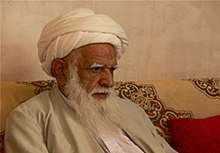Asif Mohseni
| Grand Ayatollah Asif Mohseni آیتالله العظمی محمد آصف محسنی | |
|---|---|
 | |
| Religion | Usuli Twelver Shia Islam |
| Other names | شیخ آصف محسنی |
| Personal | |
| Born |
1935 (age 82–83) Qandahār, Afghanistan |
| Senior posting | |
| Based in | Kabul, Afghanistan |
| Title | Grand Ayatollah |
| Period in office | Present |
| Religious career | |
| Post | Grand Ayatollah |
| Website | mohseny.com |
Grand Ayatollah Muhammad Asif Mohseni (Persian: آیتالله العظمی محمد آصف محسنی) (Sheik Mohseni) (born 1935) is widely considered to be the most powerful Twelver shia Marja' in Afghanistan.[1][2] He is the founder of the Islamic Movement of Afghanistan (Harakat-I Islami-yi Afghanistan).[3] With strong links to Iran,[4][5][6] he is a Shia Pashtun.[7]He was born in the city of Kandahar, Afghanistan.[3][8] He has studied in seminars of Najaf under Grand Ayatollah Abul Qasim Khoei,Muhsin al-Hakim and Abdul ala Sabzwari.
Shia Family Law
In 2009 Mohseni drafted a family law code for Afghanistan's minority Shia population.[9] The Shia Family Law legislation was signed into law by President Hamid Karzai in March 2009 after intense pressure from Shia clerics including Mohseni and some leaders of the Hazara community.[10] It gives Shiite men in Afghanistan wide-ranging powers over their wives. Shiite women must obtain permission from their husbands to leave their houses, “except in extreme circumstances.” The law also grants guardianship of children exclusively to their fathers and grandfathers.[11]
The passing of the law brought international outrage and was condemned by world leaders including US President Barack Obama. A report by the United Nations Development Fund for Women, UNIFEM, warned: "Article 132 legalises the rape of a wife by her husband".[12]
On 15 April 2009, between 200-300 Afghan women protested against the law outside Mohseni's mosque and seminary. They were met by hundreds of his enraged supporters who shouted abuse and, according to many of the demonstrators, threw stones at the women.[10] The night before the demonstration, a television station owned by Mohseni repeatedly broadcast a message advising people to prevent family members attending the protest.[2][3]
Religious, political, and business organisations
Mohseni owns Tamadon TV Network, a television station very similar in visual style and religious content to Iranian state-run television channels.[3][13]
In the 1960s Mohseni founded a movement called Subh-i Danish (Dawn of Knowledge), whose political and cultural revival program enjoyed some popularity among the Shia youth of Kabul.[14]
In 1978 he founded Harakat-I Islami-yi Afghanistan (the Islamic Movement of Afghanistan), a Shia anti-Soviet resistance movement and political party combining various smaller group with numerous bases inside and outside the country. Its headquarters was originally in the Iranian city of Qum and Mohseni received support for the group from the Iranian state.[3] The group later played an important role in the 1980 rebellion against the communist regime. Because he was a disciple of Ayatollah Khui, a rival of Khomeini, Mohseni did not have a good relationship with Khomeini's entourage. He was arrested in August 1980 in Iran, and the offices of the party in Tehran were closed down, after the Iranian authorities claimed he was being financed by the CIA.[14] Among the anti-communist resistance movements, Harakat espoused a moderate islamist line, which brought it close to the sunni Jamiat Islami faction, that had a similar outlook. Mohseni's movement resisted from different Afghan cities and his forces included mainly Hazara Mujahideen.[15]
References
- ↑ Mackey, Robert. "Afghan Husbands Win Right to Starve Wives." New York Times. N.p., 17 Aug. 2009. Web. 9 June 2015.
- 1 2 Farmer, Ben. "Shia Cleric Defends Law Said to Legalise Marital Rape." The Telegraph. Telegraph Media Group, 16 Apr. 2009. Web. 08 June 2015.
- 1 2 3 4 5 Arbabzadah, Nushin (18 April 2009). "Afghanistan's turbulent cleric". The Guardian. Retrieved 18 August 2017.
- ↑ Zarif, Maseh, and Ahmad Majidyar. "Iranian Influence in Afghanistan: Recent Developments." Iran Tracker. N.p., 21 Aug. 2009. Web. 9 June 2015.
- ↑ Nazar, Zarif, and Charles Recknagel. "Controversial Madrasah Builds Iran's Influence In Kabul." Radio Free Europe/Radio Liberty. N.p., 6 Nov. 2010. Web. 9 June 2015.
- ↑ Rubin, Michael. "Iranian Influence in the South Caucasus and the Surrounding Region." American Enterprise Institute. N.p., 5 Dec. 2012. Web. 9 June 2015.
- ↑ Baiza, Yahia (2013-08-21). Education in Afghanistan: Developments, Influences and Legacies Since 1901. Routledge. ISBN 9781134120826.
- ↑ http://www.sabawoon.com/articles/index.php?page=kite_runner
- ↑ Oates, Lauryn. "Lauryn Oates: Murder in the Streets of Kabul." National Post. Postmedia Network Inc., 30 Mar. 2015. Web. 08 June 2015.
- 1 2 Boone, Jon (18 April 2009). "Afghanistan's Women Find Their Voice". The Guardian. Retrieved 18 August 2017.
- ↑ "Afghanistan: Law Curbing Women's Rights Takes Effect." Afghanistan: Law Curbing Women's Rights Takes Effect. N.p., 14 Aug. 2009. Web. 9 June 2015.
- ↑ Shakir, Faiz. "Obama Responds To Afghan Law That Legalizes Rape: ‘I Think This Law Is Abhorrent’." ThinkProgress. Center for American Progress, 04 Apr. 2009. Web. 08 June 2015.
- ↑ Gall, Carlotta, and Sangar Rahimi. "Karzai Vows to Review Family Law." The New York Times. The New York Times, 04 Apr. 2009. Web. 9 June 2015.
- 1 2 Rubin, Barnett (1995). The fragmentation of Afghanistan: State formation and collapse in the international system. New Haven and London: Yale University Press. p. 222. ISBN 0-300-05963-9.
- ↑ Roy, Olivier (1990). Islam and resistance in Afghanistan. Cambridge: Cambridge University Press. p. 146. ISBN 0-521-39700-6.